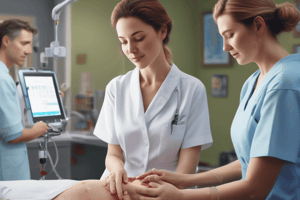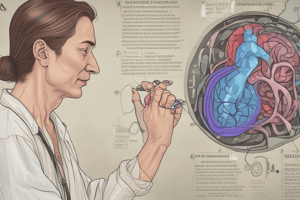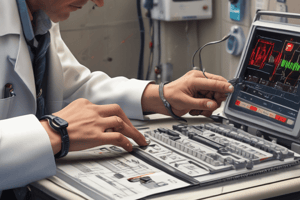Podcast
Questions and Answers
In clients with certain lung conditions such as emphysema, what is the preferred target range for oxygen saturation?
In clients with certain lung conditions such as emphysema, what is the preferred target range for oxygen saturation?
- Greater than 98%
- Between 96% and 98%
- Less than or equal to 95% (correct)
- Greater than 95%
The force exerted on the walls of an artery under pressure from the heart defines which vital sign?
The force exerted on the walls of an artery under pressure from the heart defines which vital sign?
- Oxygen saturation
- Blood pressure (correct)
- Pulse rate
- Respiratory rate
Which of the following is the most common site to measure pulse in adults?
Which of the following is the most common site to measure pulse in adults?
- Brachial pulse
- Radial pulse (correct)
- Femoral pulse
- Carotid pulse
A stroke volume of approximately how many mL of blood is associated with each ventricular contraction?
A stroke volume of approximately how many mL of blood is associated with each ventricular contraction?
Which of the following is NOT a primary factor influencing blood pressure?
Which of the following is NOT a primary factor influencing blood pressure?
According to the provided information, which systolic blood pressure reading would be considered concerning?
According to the provided information, which systolic blood pressure reading would be considered concerning?
According to the gate control theory of pain, which process involves the activation of nociceptors by a noxious stimulus?
According to the gate control theory of pain, which process involves the activation of nociceptors by a noxious stimulus?
In the context of pain management, which domain of pain incorporates the patient's coping strategies?
In the context of pain management, which domain of pain incorporates the patient's coping strategies?
Why is acute pain considered purposeful? Choose the MOST accurate answer.
Why is acute pain considered purposeful? Choose the MOST accurate answer.
Which aspect of the pain physiology involves the efferent pathways?
Which aspect of the pain physiology involves the efferent pathways?
Which of the following assessment techniques is typically performed first in a physical assessment?
Which of the following assessment techniques is typically performed first in a physical assessment?
A client is documented as 'afebrile.' What does this term indicate?
A client is documented as 'afebrile.' What does this term indicate?
What physiological process is indicated by the term 'diaphoresis'?
What physiological process is indicated by the term 'diaphoresis'?
A medication is prescribed as an 'antipyretic.' What is the primary purpose of this medication?
A medication is prescribed as an 'antipyretic.' What is the primary purpose of this medication?
Which of the following heart rates would be classified as 'tachycardia'?
Which of the following heart rates would be classified as 'tachycardia'?
What term describes the absence of a pulse due to the heart's lack of contraction?
What term describes the absence of a pulse due to the heart's lack of contraction?
What does assessing 'excursion' involve during a physical assessment?
What does assessing 'excursion' involve during a physical assessment?
A patient's oxygen saturation is measured at 88%. According to the information provided, how should this be interpreted?
A patient's oxygen saturation is measured at 88%. According to the information provided, how should this be interpreted?
Explain how a bacterial infection can induce a fever, detailing the mechanism involving a specific substance.
Explain how a bacterial infection can induce a fever, detailing the mechanism involving a specific substance.
During an assessment, a nurse notes a significant difference between the radial and apical pulse rates. This finding could indicate various underlying conditions, but what specific cardiovascular inefficiency does it MOST directly suggest?
During an assessment, a nurse notes a significant difference between the radial and apical pulse rates. This finding could indicate various underlying conditions, but what specific cardiovascular inefficiency does it MOST directly suggest?
Flashcards
Health Assessment
Health Assessment
The systematic collection of subjective and objective data to determine a client's health status.
Inspection
Inspection
Looking at the patient, always done first.
Palpation
Palpation
Using touch to assess texture, temperature, moisture, organ location, swelling, vibration, or crepitation.
Percussion
Percussion
Signup and view all the flashcards
Auscultation
Auscultation
Signup and view all the flashcards
Afebrile
Afebrile
Signup and view all the flashcards
Pyrogen
Pyrogen
Signup and view all the flashcards
Diaphoresis
Diaphoresis
Signup and view all the flashcards
Antipyretic
Antipyretic
Signup and view all the flashcards
Oxygen Saturation
Oxygen Saturation
Signup and view all the flashcards
Blood Pressure (BP)
Blood Pressure (BP)
Signup and view all the flashcards
Systolic Pressure
Systolic Pressure
Signup and view all the flashcards
Diastolic Pressure
Diastolic Pressure
Signup and view all the flashcards
Five Factors of BP
Five Factors of BP
Signup and view all the flashcards
Concerning Blood Pressure Values
Concerning Blood Pressure Values
Signup and view all the flashcards
Pain
Pain
Signup and view all the flashcards
Domains of Pain
Domains of Pain
Signup and view all the flashcards
Transduction (Pain)
Transduction (Pain)
Signup and view all the flashcards
Transmission (Pain)
Transmission (Pain)
Signup and view all the flashcards
Perception (Pain)
Perception (Pain)
Signup and view all the flashcards
Study Notes
- 1180: Holistic Health Assessment focuses on health assessment skills
Health Assessment
- Involves collecting history and physical assessments to determine the purpose and type of assessment
Health History Types
- Focused health history is common and collects data on something specific like a body part, injury, or problem
- Emergent health history is abbreviated, urgent, and restricted to what needs to be known immediately
- Comprehensive health history focuses on gathering information on everything, such as all body systems, and provides a broad assessment of the client's health through annual medical exams or when joining a new primary health team
Why Perform Physical Assessments
- To obtain baseline data to supplement, confirm, or refute nursing history data
- To establish nursing diagnoses and plans of care
- To evaluate the physiological outcomes of healthcare via client health and make clinical judgements
- Advanced assessments helps distinguish between differential diagnoses
- Consists of inspection, palpation, percussion (advanced, determines density), and auscultation (w/ stethoscope)
Clinical Judgement
-
Clinical Judgement requires Interpreting, Responding, Reflecting, Noticing new information
-
Requires understanding the clinical situation and nurse's contribution using a holistic view
Data Types
- Subjective includes information reported by the client influenced by experience, opinions, or preferences
- Provides clues to physiologic, psychological, and sociologic problems like sensations, feelings and personal information
- Objective includes information measured or observed through senses such as physical assessment, observation and diagnostic testing
- A general survey that takes into account clients mental state and behavior
- Takes place during initial encounter and provides a snapshot in time, which can be used to determine any changes
The ASEPTIC acronym
| Acronym | Description |
|---|---|
| Appearance | |
| Speech | |
| Emotion | |
| Perception | |
| Thought Process | |
| Insight | |
| Cognition |
Vital Signs
- Includes Temperature which can be measured
- Afebrile means no fever is present
- Pyrogen, a substance such as bacteria that produces fever when introduced to/present in the bloodstream
- Diaphoresis indicates sweating
- Antipyretic is a substance such as acetaminophen or ibuprofen that combats fever, which indicates sweating
Pulse/Respiration
- Bradycardia occurs when heart rate is below 60 bpm
- Tachycardia occurs when heart rate is above 100 bpm
- Arrhythmia is an abnormal/irregular heartbeat
- Pulse deficit represents an abnormal difference in rate between radial/apical sites
- Asystole indicates an absent pulse
- Apnea represents periods of no breathing/respiration
- Excursion is assessed by placing hands on client's back to look for symmetrical chest expansion with breathing
- Temperature ranges include 36.5-37.5°C under the tongue, 35.9-37.2°C under the arm, 36.5-37.5°C in the ear, 36.5-37.5°C on the forehead, and 37.0-37.5°C in the rectum
Oxygen Saturation
- Measures the percentage of hemoglobin molecules on red blood cells that are oxygen-bound, where each hemoglobin can carry 4 oxygen molecules
- Normal range is between 92-100%, with a preference over 95%
- Ranges over 95% are less preferred w/ as with clients with certain lung conditions like emphysema
- Normal pulse pressure is typically ~ 40-60 mmHg
Respiratory
- Normal rate for adults is 12 to 20 breaths per minute, varying by age for children
- Assessed before/after a treatment or procedure, when the patient's condition changes, or when physician orders dictate
Pulse Measurement
- Pulse wave originates from ventricular contraction (~60 mL stroke volume) and travels through the aorta to distal arteries
- Radial pulse is the most common measurement site, though hard to find in children age 3 and below
- Apical pulse is used to check pulse rate in children under 2 years of age or when an abnormal/irregular rate is found via palpation of peripheral pulses
- Blood pressure represents the force exerted on artery walls from the heart, with Systolic (top) and Diastolic (bottom) numbers
Blood Pressure
- Influenced by cardiac output, peripheral vascular resistance, circulating blood volume, viscosity, and vessel wall elasticity
Hypertension Factors
-
Low Risk: Systolic ≤ 120 and Diastolic ≤ 80
-
Medium Risk: Systolic 121-139 or Diastolic 81-89
-
High Risk: Systolic 140+ or Diastolic 90+ Hypotension: Systolic <90 or Diastolic <60
-
Concerning blood pressure when
- Systolic is lower than 100 or higher than 139
- Diastolic is lower than 60 or higher than 89
-
Term Definitions -Hypertension: A blood pressure above the expected range -Hypotension: A blood pressure below the expected range -Orthostatic/Postural Hypotension: A sudden blood pressure drop when standing from a seated or prone position -Pulse Pressure: The difference between systolic and diastolic BP
Pain
- Pain is a primary reason clients access healthcare in Canada
- Pain's Physiology
- Gate control theory
- Transduction: A noxious stimulus causes "gate" opening on a nociceptor through nerve depolarization -Transmission: Noxious stimuli passes through the peripheral to central nervous system up the afferent (nerves to the brain) nerve pathways -Perception: The pain stimulus passes through the dorsal horn of the spine and cerebral cortex -Modulation: Stimulus is identified as pain in cerebral cortex and a pass down the efferent pathways, resulting in a response
- Duration: Is either Acute or Chronic -Acute means from actual/potential tissue damage, has a purpose to further alert and protect, lasts less than 6 months and can have physiologic changes -Chronic means lacks acute warning, doesn't have a purpose, has more emotional effects, and lasts longer than 6 months
- Other Pain Types -Frequency: Continuous (constant), Intermittent (comes and goes) and Episodic (particular event/cycles) -Form types include Nociceptive, Neuropathic and Associated with Cancer
- Subjective - Nociceptive is tissue/can be thermal - Visceral is heart and kidney/can be crampy or numb - Somatic is muscles, bones joint/can be sharp pain
- Also types include Cutaneous, Rreferred parietal and Neuropathic
ASEPTIC mnemonic is used to
| NEUROPATHIC PAIN | ||
|---|---|---|
| Pressure | Burning | Tingling |
| Radiating | Crushing | Gnawing |
| Sharp | Cramping | Heavy |
| Sickening | Dull | Electric |
Infection Controls/Self Study
- NOSOCOMIAL indicates infections acquired in the hospital
- Aseptic represents "Clean" technique, where microorganisms are reduced, not completely eliminated
- Chain of infection: This is the circuit that, without interruption, produces an infection, meaning breaking 1 part interrupts this infection
- Microorganisms represented by bacteria, viruses, fungi, or parasites
- Types
- Pathogen: A microorganism that causes disease
- Sterile: Complete eradication of microorganisms, unlike clean technique
- HAI: Infection the client acquired while in the hospital, also known as nosocomial infections
- Contact: Includes humans, and indirect contact which involves transmission
- Four moment of hand hygiene -Before entering the room for washing -Before aseptic procedures Before/after glove exposure, after exiting the room
Precautions Types
- Contact: Includes humans, and indirect contact which involves transmission
- Wear a gown and gloves to protect hands and uniforms against contact with pathogens.
- Droplet: Large released particles during sneezing which requires eyewear to filter out large partiles
-Airborne: For situations involving very small particles suspended in the air
- Requires N95-type respirator to prevent infection vs Aseptic
Transmission Chain Info
- Infectious organism: Microogranisms used to cause illness (viruses, bacteria/fungi)
- "Reservoir": The place for infectous organism needs room to live.
- Portal of Exit: The method used by organism in order to leave reservior.
- Transmission: Pathgen goes from one host to another.
Spinal Nerve Details
- Dermatone: Area of skin, supplied by nerve fibres
- Paraesthesia:"Pins & Needles" to related injury.
- Persyncope: The sensation of fainting
- Syncope - Fainting
- Diplopia: Double vision
- Tinnitus: Ringing
Cranial info with functions/names
| Number | Location | Function/Mnemonic | | | ----------- | ----------- | ----------- | |I | Olfactoy | Some | | II| Optic | Old | Say | |III| Oculomotor | Olympus' | Marry | |IV| Trochlear | Towing | Money | |V| Trigeminal | Top | But | |VI | Abducens | A| MY | |VII |Facial | Fin |Brother | |VIII |Auditory or Vestibulochochlear| And |Says |IX |Glossopharyngeal | German |BIG | |X| Vagus | Viewed |Brains | |XI| Spinal Accessory | Some | |XII
Studying That Suits You
Use AI to generate personalized quizzes and flashcards to suit your learning preferences.




